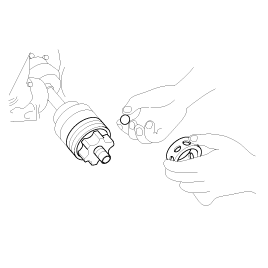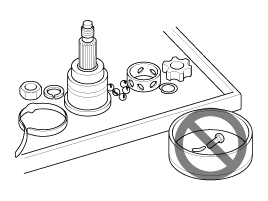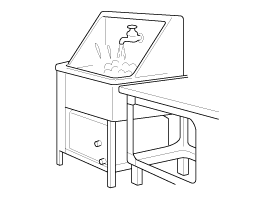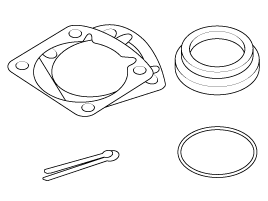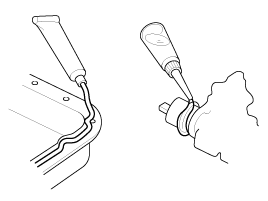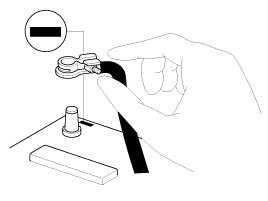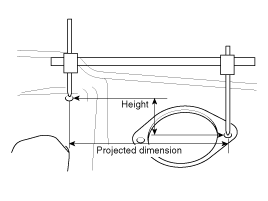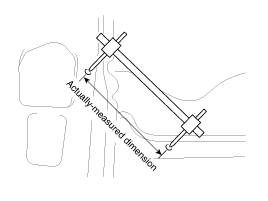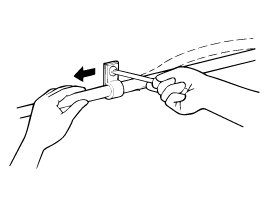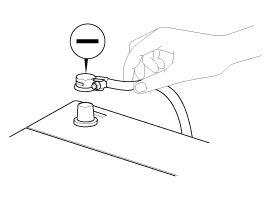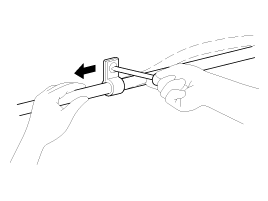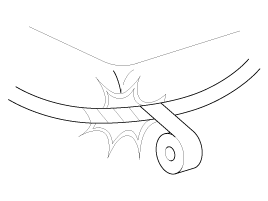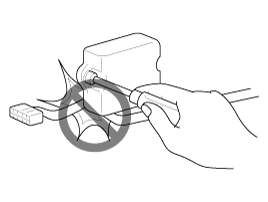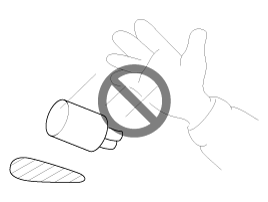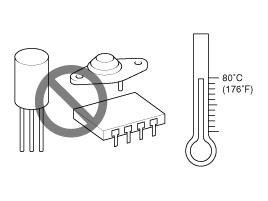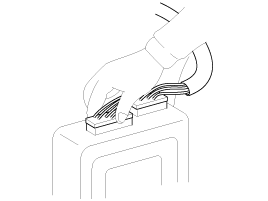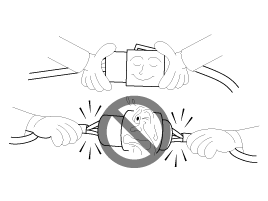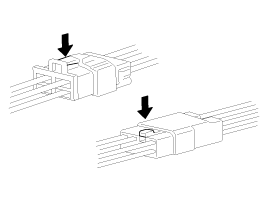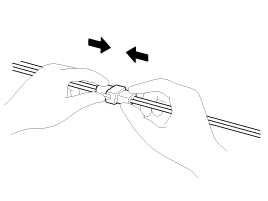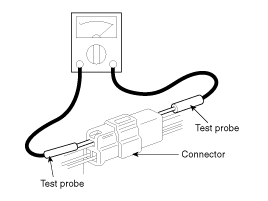Kia Soul EV: General Service Information / General Information
Kia Soul EV (PS EV) 2015-2020 Service Manual / General Information / General Service Information / General Information
| General Service Information |
Protection Of The Vehicle
Always be sure to cover fenders, seats, and floor areas before starting work.
The support rod must be inserted into the hole near the edge
of the hood whenever you inspect the engine compartment to prevent the
hood from falling and causing possible injury.
Make sure that the support rod has been released prior to
closing the hood. Always check to be sure the hood is firmly latched
before driving the vehicle. |
Preparation Of Tools And Measuring Equipment
Be sure that all necessary tools and measuring equipment are available before starting work.
Special Tools
Use special tools as needed
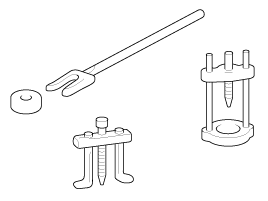
Removal Of Parts
First, find the cause of the problem and then determine whether to remove or disassemble before starting the job.
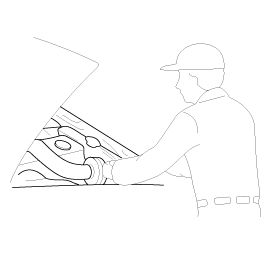
Disassembly
If the disassembly procedure is complex, requiring many parts
to be disassembled, all parts should be disassembled in a way that will
not affect their performance or external appearance.
| 1) |
Inspection of parts
Each removed part should be examined carefully for any suspected malfunctions, deformantion, damage and other problems.
|
| 2) |
Arrangement of parts
All disassembled parts should be carefully arranged for effective reassembly.
Be sure to separate and correctly identify parts to be replaced from reusable parts.
|
| 3) |
Cleaning parts for reuse
All reusable parts should be carefully and thoroughly cleaned by an appropriate method.
|
Parts
When replacing parts, use KIA MOTORS genuine parts.
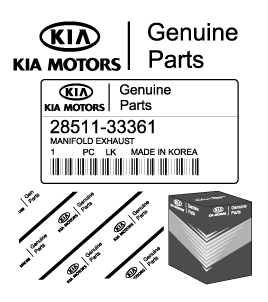
Replacement
Standard values, such as torques and certain adjustments, must be strictly observed in the reassembly of all parts.
Once removed, the following parts should always be replaced with new ones.
| 1) |
Oil seals |
| 2) |
Gaskets |
| 3) |
O-rings |
| 4) |
Lock washers |
| 5) |
Cotter pins (split pins) |
| 6) |
Plastic nuts
Depending on their location. |
| 7) |
Sealant should be applied to gaskets. |
| 8) |
Oil should be applied to the moving components of parts. |
| 9) |
Specified oil or grease should be applied to the prescribed locations (oil seals, etc) before assembly.
|
Adjustment
Use gauges and testers to correctly adjust the parts according to standard values.
Electrical System
| 1. |
Be sure to disconnect the battery cable from the negative (-) terminal of the battery. |
| 2. |
Never pull on the wires when disconnecting connectors. |
| 3. |
Locking connectors will click when the connector is secure. |
| 4. |
Handle sensors and relays carefully. Be careful not to drop them against other parts.
|
Rubber Parts And Tubes
Always keep rubber pats and tubing away from gasoline.
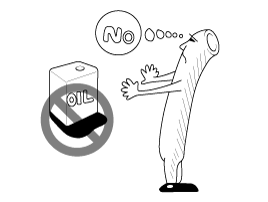
Measuring Body Dimensions
| 1. |
Basically, all measurements in this manual are taken with a tracking gauge. |
| 2. |
When a measuring tape is used, check to be sure there is no elongation, twisting or bending. |
| 3. |
For measuring dimensions, both projected dimensions and actual - measurement dimensions are used in this manual. |
Dimensions Projected
| 1. |
These are the dimensions measured when the measurement points
are projected from the vehicle''s surface, and are the reference
dimensions used for body alterations. |
| 2. |
If the length of the tracking gauge probes is adjustable,
measure it by lengthening one of two probes as long as the height
difference between two surfaces.
|
Measuring Actual Dimensions
| 1. |
These dimensions indicate the actual linear distance between
measurement points, and are used as the reference dimensions when a
tracking gauge is used for measuring. |
| 2. |
First adjust both probes to the same length (A=A'') before measuring.
|
Measurement Point
Measurements should be taken at the center of the hole.
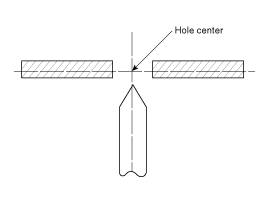
Checking Cables And Wires
| 1. |
Check the terminal for tightness. |
| 2. |
Check terminals and wires for corrosion from battery electrolyte, etc. |
| 3. |
Check terminals and wires for open circuits. |
| 4. |
Check wire insulation and coating for damage, cracks and degrading. |
| 5. |
Check the conductive parts of terminals for contact with other metallic parts (vehicle body and other parts). |
| 6. |
Check grounded parts to verify that there is complete continuity between their attaching bolt(s) and the vehicle''s body. |
| 7. |
Check for incorrect wiring. |
| 8. |
Check that the wiring is so clamped to prevent contact with
sharp corners of the vehicle body, etc. or hot parts (exhaust manifold,
etc.) |
| 9. |
Check that the wiring is clamped firmly to provide enough
clearance from the fan pulley, fan belt and other rotating or moving
parts. |
| 10. |
Check that the wiring has a little space so that it can
vibrate between fixed and moving parts such as the vehicle body and the
engine.
|
Check Fuses
A blade type fuse test taps are provided to allow checking
the fuse itself without removing it from the fuse box. The fuse is good
if the test lamp lights up when one lead is connected to the test taps
(one at a time) and the other lead is grounded. (Turn the ignition
switch so that the fuse circuit becomes operative)
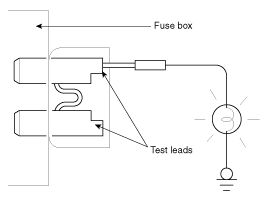
Servicing The Electrical System
| 1. |
Prior to servicing the electrical system, be sure to turn off the ignition switch and disconnect the battery ground cable.
|
| 2. |
Attach the wiring harnesses with clamps so that there is no
slack. However, for any harness which passes the engine or other
vibrating parts of the vehicle, allow some slack within a range that
does not allow the engine vibrations to cause the harness to come into
contact with any of the surrounding parts and then secure the harness
using a clamp.
|
| 3. |
If any section of a wiring harness interferes with the edge
of a parts, or a corner, wrap the section of the harness with tape or
something similar in order to protect it from damage.
|
| 4. |
When installing any parts, be careful not to pinch or damage any of the wiring harness.
|
| 5. |
Never throw relays, sensors or electrical parts, or expose them to strong shock.
|
| 6. |
The electronic parts used in the computer, relays, etc. are
prone to heat. If there is a need for service operations that may cause
the temperature to exceed 80°C (176°F), remove the electronic parts
before handling.
|
| 7. |
Loose connectors cause problems. Make sure that the connectors are always securely fastened.
|
| 8. |
When disconnecting a connector, be sure to grip only the connector, not the wires.
|
| 9. |
Disconnect connector which have catches by pressing in the direction of the arrows as in the illustration.
|
| 10. |
Connect connectors which have lock tabs by insertingthe connectors until they make a clicking sound.
|
| 11. |
When using a circuit tester to check continuity or voltage on
connector terminals, insert the test probe into the harness side. If
the connector is a sealed connector, insert the test probe through the
hole in the rubber cap until it touches contacts the terminal, being
careful not to damage the insulation of the wires.
|
| 12. |
To avoid overloading the wires, determine the appropriate
wire size considering the electrical current load of the optional
equipment.
| ||||||||||||||||||||||||||||||||||
Other information:
Kia Soul EV (PS EV) 2015-2020 Service Manual: ESP OFF Switch Repair procedures
Removal 1. Turn ignition switch OFF and disconnect the negative (-) battery cable. 2. Remove the crash pad lower panel. (Refer to Body - "Crash Pad Lower Panel") 3. Remove the lower crash pad switch assembly (A) by pushing it. 4. Disconnect the connectors (A) from the lower crash p ...
Kia Soul EV (PS EV) 2015-2020 Service Manual: Components and Components Location
Components 1. Front seat headrest2. Front seat headrest guide3. Front seat back cover4. Front seat back heater5. Front seat back pad6. Front seat back lumbar assembly7. Front seat back frame assembly8. Front seat back board9. Front seat cushion cover10. Front seat cushion heater11. Front seat c ...
Copyright © www.ksoulev.com 2020-2025



